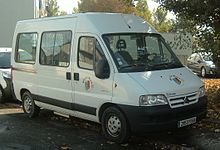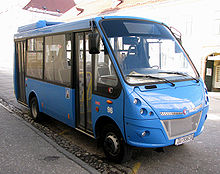Minibus
This article needs additional citations for verification. (February 2023) |




A minibus, microbus, or minicoach is a passenger-carrying motor vehicle that is designed to carry more people than a multi-purpose vehicle or minivan, but fewer people than a full-size bus. In the United Kingdom, the word "minibus" is used to describe any full-sized passenger-carrying van or panel truck. Minibuses have a seating capacity of between 12 and 30. Larger minibuses may be called midibuses. Minibuses are typically front-engine step-in vehicles, although low floor minibuses are particularly common in Japan.[1]
History
[edit]It is unknown when the first minibus vehicle was developed. For example, Ford Model T vehicles were modified for passenger transport by early bus companies and entrepreneurs.[2] Ford produced a version during the 1920s to carry up to twelve people.[3][4][5]
In the Soviet Union, the production of minibuses began in the mid-1950s, among the first mass-produced minibuses were the RAF-10, UAZ-451B, and Start.[6] Since September 1961, the RAF-977D "Latvia" minibus began to be mass-produced.[7]
Regional variants
[edit]There are many different form of public transportation services around the world that are provided by using vehicles that can be considered as minibus:
- Angkot in Indonesia
- Bas Mini in Malaysia
- Chiva bus in Colombia and Ecuador
- Colectivo in southern South America
- Community bus (Japanese コミュニティバス komiunitibasu) in Japan (Include minibus and midibus)
- Dala dala in Tanzania
- Dollar van a.k.a. jitneys, in the United States.
- Dolmuş in Turkey
- Modern Jeepney in the Philippines
- Maeul-bus (Korean 마을버스) in South Korea
- Marshrutka in eastern Europe.
- Matatu around Kenya
- Minibus taxi in South Africa, Ethiopia, see also Taxi wars in South Africa
- Pesero, minibuses operating as regular buses in Mexico, especially in Mexico City.
- Public light buses, in Hong Kong.
- Sherut in Israel
- Songthaew around Thailand and Lao
- Tap tap in Haiti
- Tro tro around Ghana
- Weyala in Ethiopia
Driving licence
[edit]Some countries may require an additional class of driving licence over a normal private car licence, and some may require a full commercial driving licence. The need for such a licence may depend on:
- Vehicle weight or size
- Seating capacity
- Driver age
- Intended usage
- Additional training (such as the Minibus Driver Awareness Scheme in the UK)
In the UK: The holder of an ordinary car driving licence which was obtained prior to January 1997, once aged 21 years minimum, may drive a Minibus with a capacity of 16 passengers. Where the "ordinary car driving licence" is obtained after December 1996, they will have to take a separate test to drive a vehicle with a capacity of more than 8 passengers. However, there is an exemption for certain volunteer drivers, where the vehicle does not exceed 3500 kg GVW (or 4250 kg GVW if the vehicle is designed to be wheelchair accessible).
A driving licence issued in Ontario, Canada, for an equivalent of a UK class B or class B-auto driving licence (in the case of Ontario, a class G licence), allows its holder to drive vehicles with:
- 11 tonnes maximum authorized mass, including trailers with 4.6 tonnes MAM[8] 6 tonnes MAM in certain cases)
- passenger seating capacity of 9 or less
Anyone wanting to drive a vehicle in Ontario, with the same MAM limits as for class G vehicles, with fewer than 25, but at least 10, passenger seats, must obtain a bus licence. This will allow, for example, its holder to drive 12- and 15-passenger vans] that Transport Canada defines as large passenger vans.[9]
See also
[edit]References
[edit]- ^ Akiyama, Tetsuo; Wahira, Yoshihiro; Kamata, Minoru; Fujii, Naoto (2001). "Vehicle Accessibility in Japan Today and the Outlook for the Future". IATSS Research. 25: 42–50. doi:10.1016/S0386-1112(14)60005-4. Retrieved 14 November 2024.
- ^ Negyesi, Pal (4 May 2020). "The Role of the Ford Model T As a Bus in Central and Eastern Europe". CEAutoClassic. Retrieved 17 February 2023.
- ^ "Henry the Model T Bus". highfieldspioneervillage.com.au. Retrieved 17 February 2023.
- ^ "1926 Ford Model TT 10 Seater Country Bus Chassis no. 14390021 Engine no. 14390021". bonhams.com. Retrieved 17 February 2023.
- ^ "Car Ford Model T Station Bus 1919 for sale". PreWarCar. Retrieved 17 February 2023.
- ^ Dashko, Dmitry (2013). Юность. Автобус для избранных [Youth. A bus for the elite] (in Russian). ООО "ИПК Парето-Принт". pp. 19–21.
- ^ "Хроника: любимый «рафик»" (in Russian). Retrieved 16 January 2025.
- ^ "Licence Change for Operators of Recreational Vehicles". Archived from the original on 3 July 2011.
- ^ "Road Safety and Motor Vehicle Regulation Directorate". Archived from the original on 3 December 2013.

